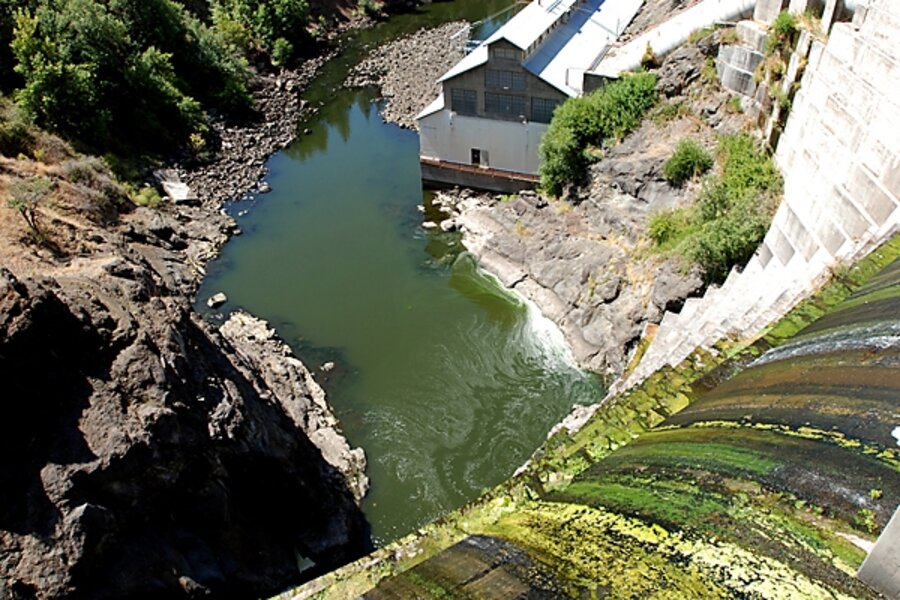Klamath River dam-removal project will be world's biggest
Loading...
| San Francisco
Many environmental groups greeted Wednesday’s draft agreement to tear down four dams and restore the Klamath River along the California-Oregon border with a healthy degree of skepticism.
The decision to remove the hydroelectric dams that are operated by PacifiCorp comes after years of growing pressure on one of the largest Western utilities to address a raft of environmental issues – namely blocking salmon and steelhead runs but also the creation of toxic algae.
In total, 28 parties including PacifiCorp, California, Oregon, American Indian tribes, federal agencies, and conservation groups signed onto the draft that would bring the dams down in 2020 and amount to a river restoration project of historic proportion.
“When the Klamath dams come down it will be the biggest dam removal project the world has ever seen. It is exciting to see the momentum behind this historic river restoration effort – one that promises to not only restore the health of the river, but also boost local economies and revitalize communities,” said Steve Rothert, California director for the environmental group American Rivers, made in a statement.
Words of caution
But while many stakeholders greeted the decision with praise, others offered much caution.
"We support local stakeholders’ efforts to craft an agreement that works for everyone, but it remains to be seen whether this agreement will hold water,” said Erica Terence of the organization Klamath Riverkeeper in a statement.
The group says it is particularly concerned about a new clause that would give California, Oregon, the federal government, and PacifiCorp the power to amend the agreement without the consent of other parties under some circumstances.
As the Associated Press reports, the dam removal project will not be cheap.
“PacifiCorp will not bear the estimated $450 million cost of removing the dams. Oregon has approved $180 million in surcharges on state ratepayers. Another $250 million depends on California approving general obligation bonds,” according to the news agency.
That high price tag has many concerned.
“California budget cuts have caused drastic cutbacks in public safety, health, education, and environmental programs. It doesn’t seem possible that the state will have the money any time soon to help implement the restoration project,” said Steven Evans of the California group Friends of the River in a statement.
“It’s going to take a lot more work and effort by all parties to ensure that the dams are actually removed and the Klamath River salmon are restored in our lifetime,” Mr. Evans said.
Complications over a water deal?
At least one group, Oregon Wild, questions what connection the dam removal might have to the broader water deal in the region negotiated by the Bush administration.
“Even more controversial is the linkage between the [dam agreement] and ... a nearly $1 billion water deal drafted over the last six years and heavily influenced by former Bush administration officials. [These] negotiations have proceeded in secret since a draft document was released to the public in January of 2008. The settlement scheme would guarantee water for commercial agriculture in the Bureau of Reclamation’s Klamath Irrigation Project without providing a similar guarantee to threatened fish species,” the groups said.
“The dam deal announced today isn’t perfect, but the true test is still to come,” said Steve Pedery, conservation director with Oregon Wild. “When the water deal gets packaged with this dam deal, are river advocates going to be able to live with the fish and wildlife sacrifices made in the final settlement? We all want dam removal, but we shouldn’t have to trade salmon and bald eagles for broken concrete.”
A step forward
While the agreement still has many hurdles to clear, most heralded it as an important step forward for the environmentalist cause.
“This Agreement represents a major step toward restoring the health of the Klamath River. We look forward to working with all Tribal, agricultural, and fishing communities in the Klamath Basin on implementing these solutions,” said Troy Fletcher, negotiator and Yurok tribal member.
The Obama administration also weighed in.
Interior Secretary Ken Salazar said: "This agreement marks the beginning of a new chapter for the Klamath River and for the communities whose health and way of life depend on it. Hats off to all the stakeholders who have worked so hard to find common ground on one of the most challenging water issues of our time."
-----
Follow us on Twitter.





